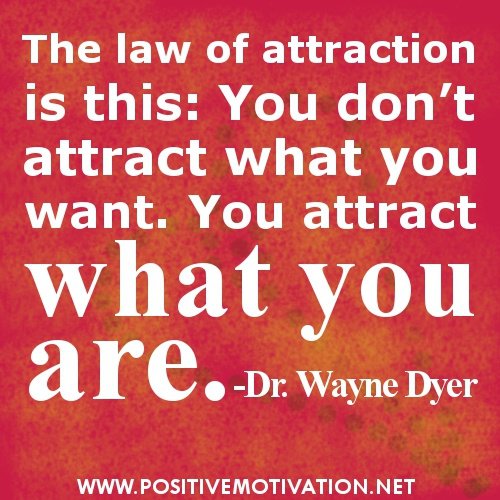Why are People Attracted to One Another?

Relationships and Attraction
Jean Baptiste Antoine Suard, a French journalist, once said, “we attract hearts by the qualities we display; we retain them by the qualities we possess.” According to this quote, people are attracted to one another because of the qualities one displays, but people stay together because of the true qualities that person possesses. One definition of attraction according to the Merriam-Webster dictionary is “a force acting mutually between particles of matter, tending to draw them together, and resisting their separation.” The first half of this paper delves deeper into what the force entails and why people are drawn together. The second half looks into the different types of relationships people engage in once attraction draws them in.
The classic perspective claims that “people are attracted to those with whom they can have a relationship that is rewarding” (Kassin, Fein, & Markus, 2011, p. 343). The rewards can vary, as some are direct while others may be indirect (Kassin, Fein, & Markus, 2011, p. 343). Direct rewards occur when a person tends to another’s desires. Those desires could be attention, money, or status (Kassin, Fein, & Markus, 2011). Indirect rewards occur when a person is with someone who makes him/her feel good. The person may be loving, good looking, or caring and that makes the other person feel good about themselves.
Spousal Atrraction
What attracted you to your spouse?
The second perspective, which is the evolutionary perspective, claims that “human beings all over the world exhibit patterns of attraction and mate selection that favor the conception, birth, and survival of their off spring” (Kassin, Fein, & Markus, 2011, p. 344). Evolutionary psychology perspectives “contend that complex structures in the social and the biological world have developed over time through causal processes that require little or no foresight but considerable trial and error” (Murmann, 2004, p. 1). “Women should be attracted to men who are older and financially secure or who have ambition, intelligence, stability, and other traits predictive of future success” (Kassin, Fein, & Markus, 2011, p. 358). “Men seek out women who are young and physically attractive (having smooth skin, full lips, lustrous hair, good muscle tone, and other youthful features)-attributes that signal health and reproductive fertility” (Kassin, Fein, & Markus, 2011, p. 358).
The evolutionary perspective is saying that men and women are attracted to others not because of looks or external rewards, but because of reasons that center around unborn children. When looking for a mate, men and women are going to be attracted to someone that can offer a positive conception, birth, and lifestyle for future children.
The proximity effect explains one factor that is necessary in the attraction process. The Merriam-Webster online collegiate dictionary explains that proximity is “the state or condition of being near: closeness.” What the proximity effect means is that people are more likely to be attracted to those who they interact with in proximity. This could be at work, school, the neighborhood, the gas station, etc. Research on the subject has “shown that college students—who live in off campus apartments, dormitories, or fraternity and sorority houses—tend to date those who live either nearby (Hays, 1985) or in the same type of housing as they do (Whitbeck
& Hoyt, 1994)” (Kassin, Fein, & Markus, 2011, p. 344).
The mere exposure effect is, “the phenomenon whereby the more often people are exposed to a stimulus, the more positive they evaluate that stimulus” (Kassin, Fein, & Markus, 2011, p. 344). “When you see a person more often you will think that he is more likable than a stranger or someone you see less often” (Radwan, 2011, p. 3). After being exposed to the stimulus repeatedly, which in this case would be another person, the more likely you are to have positive thoughts and feelings towards that person.

As mentioned earlier, proximity and exposure are two factors that bring people together, but what are the other four factors? Allpsych online explains that association, similarity, reciprocal liking, and physical attractiveness in conjunction with proximity and exposure are the six reasons that humans choose certain people in which to share a relationship (Heffner, 2011).
Association has to do with how the human race “associates our opinions about other people with our current state” (Heffner, 2011, p. 9). An example of this would be meeting new people at a new job that one is happy to be at. The opinion he/she has of those people is going to be positive since he/she has positive associations with the job. If the person did not like the new job, then his/her opinion associated with the new people would be negative.
Similarity has to do with having similar viewpoints as the other person. The interaction between two people is more positive when people are similar, (Mackie & Smith, 2007). “Similar others validate our beliefs and attitudes, which leads to liking those similar others because we tend to view our own characteristics as desirable, and because support for our views is rewarding” (Mackie & Smith, 2007, p. 17 ). Take the example above for instance. If one of the people a person is working with also does not like the job, then both people will be more attracted to one another. On the other hand, if his/her co-workers enjoy the job and have different opinions than him/her, then there is no similarity.
Reciprocal liking is self-explanatory. Humans like those who like them back. “Being liked by someone is a strong reason to like this person back” (Mackie & Smith, 2007, p. 16). When a person is around others who think positive things about him/her, then he/she tends to have higher thoughts about themselves. Since the other person makes him/her feel good about themselves, he/she would be attracted to the other person. As allpsych online informs, “When we feel good when we are around somebody, we tend to report a higher level of attraction toward that person,” (Heffner, 2011, p. 11).

Physical attractiveness is an important factor in attraction. “Folklore indicates that physical beauty is a sign of inner beauty” (Berscheid & Walster, 1974, p. 14). “The common stereotype of attractive people is that they are warm, friendly, and social (Mackie & Smith, 2007, p. 4). The what-is-beautiful-is-good stereotype is “that people tend to associate physical attractiveness with other desirable qualities” (Kassin, Fein, & Markus, 2011, p. 349). This means that people assume someone who is pretty or good looking is also nice, funny, loving, etc. Studies have also shown that the more physically attractive a person is the more happier and successful he/she would become (Berscheid & Walster, 1974). Humans choose people who they think are attractive, and who match their attractiveness levels (Heffner, 2011).
After the initial attraction draws people in, what different types of relationships do they engage in? There are five dominant patterns of relationships and five collateral patterns of relationships. The five dominant patterns consist of survival relationships, validation relationships, scripted relationships, acceptance relationships, and individuation-assertion relationships. The five collateral patterns consist of healing relationships, experimental relationships, transitional relationships, avoidance relationships, and pastime relationships. Typically, dominant patterns of relationships last longer than the collateral type of relationships
(McDonald, 2013). Collateral type relationships only last a few weeks to a few years (McDonald, 2013).
The first dominant pattern relationship type is a survival relationship. Survival relationships are relationships in which partners are together because they need another person for emotional reasons, financial support, shelter, food, etc. (Lynch & Daniels, 2000). “Often the relationship is subtly or openly hostile and abusive” (Lynch & Daniels, 2000, p. 8). Partners in this type of relationship do not have much individuality, but rather “think in terms of what the other person wants them to want, and are out of touch with what they themselves want” (Lynch & Daniels, 2000, p. 9). One or both partners in the relationship may feel like they could not live life without the other partner. Though it seems that neither partner would get anything from the relationships, there is in fact a benefit of them being together. The benefit is that being with his/her partner is better than “being alone or institutionalized” (Lynch & Daniels, 2000, p. 10).
The second dominant pattern is a validation relationship. In a validation relationship “a person may seek another's validation of his or her physical attractiveness, intellect, social status, sexuality, wealth, or some other attribute” (Lynch & Daniels, 2000, p. 12). This type of relationship is insecure and the partners tend to do a lot of testing and questioning (Lynch & Daniels, 2000). Once the needs for validation have been met, the partners start to wonder if there is anything else holding the relationship together. This is when the partners drift apart and seek something different like a new partner (Lynch & Daniels, 2000).
Scripted relationships are most common among young couples who get together out of high school or college (Lynch & Daniels, 2000). “The marriage involves living out their expectations for the roles they learned they were supposed to play” (Lynch & Daniels, 2000, p. 17). The man gets a good job while the wife stays home and raises a child. These relationships are supposed to be for the long haul, but some problems can develop such as power struggles, communication issues, and being stuck in the same pattern daily (Lynch & Daniels, 2000).
Scripted relationships can move into acceptance relationships or individuation-assertion relationships. In acceptance relationships partners support, trust, and enjoy one another (Lynch & Daniels, 2000). Partners are also able to be themselves and have individuality. Individuation-assertion relationships “are based on the assertion of each person's wants and needs, and on respect for the other person's process of personal growth” (Lynch & Daniels, 2000, p. 27). The partners acknowledge one another and appreciate how they both have differences (Lynch & Daniels, 2000).

There are also five patterns of collateral relationships, and these types of relationships do not last as long as the five types described above. The first collateral type relationship is a healing relationship. “These “hook-ups” or liaisons usually occur following periods of loss, stress, struggle or mourning” (McDonald, 2013). The one engaging in the relationship needs immediate care and affection (McDonald, 2013). There is typically no passion involved, and a person could be engaging in one or more of these relationships at a time (McDonald, 2013).
In an experimental relationship, the partners are looking to try people out (McDonald, 2013). “This can open a door to finding new ways of behaving with others, and maybe discovering some things about oneself that can be expounded on” (McDonald, 2013, p. 8). If when trying people out, the two people click, then the relationship has a good chance of developing into a dominant relationship (McDonald, 2013).
A transitional relationship is “a good place to practice for a long-term relationship that's healthier than the one that preceded it” (McDonald, 2013, p. 9). These types of relationships are for changing old patterns and developing new patterns that are healthier. “The relationship is a cross between the old and the new, between patterns that drove you crazy and others that you were changing” (McDonald, 2013, p. 9).
Avoidance relationships “involves people who tend to protect themselves against deep intimacy with others” (McDonald, 2013, p. 10). Some people involved in these relationships have inner conflict with their emotions, and they try to avoid addressing it. Other people involved in these relationships may be coming out of relationships that left them hurting or they could be upset and trying to get over the death of a loved one (McDonald, 2013).
The last type of collateral pattern is a pastime relationship. This type is for recreational purposes only. The relationship is more about fun rather than love. A good example of a pastime relationship would be a summer romance (McDonald, 2013). “Passionate, delightful, and tender while it lasts, there's no expectation that it should be more than that” (McDonald, 2013, p. 12).
Physical beauty is not the only predictor of attraction. As shown above, there are six factors that describe why people are attracted to others. Association, similarity, reciprocal liking, physical attractiveness, proximity, and exposure are the six factors. Once people are drawn to one another, there are ten different types of relationships that they may be engaging in. Five of those are dominant patterns of relationships and the other five are collateral patterns. For a recap, the dominant ones are survival, validation, scripted, acceptance, and individuation-assertion. The five collateral patterns are healing, experimental, transitional, avoidance, and pastime.
References
Berscheid, E., & Walster, E., (1974). Physical Attractiveness. In L. Berkowitz (ed.,) Advances in Experimental Social Psychology. Vol. 7. Retrieved from http://faculty.babson.edu/krollag/org_site/soc_psych/berscheid_attract.html
Heffner, C. (2011). Our View of Self and Others. Heffner Media Group, INC. Retrieved from
http://allpsych.com/psychology101/attribution_attraction.html
Kassin, S., Fein, S., & Markus, H.R. (2011). Social psychology (8th Ed.). Boston: Houghton Mifflin Company ISBN: 9780495812401 (Available as eBook)
Lynch, C. & Daniels, V., (2000). Patterns of Relationships. Sonoma State University. Retrieved from http://www.sonoma.edu/users/d/daniels/lynch.html
Mackie, D. & Smith, E. (2007). Initial Attraction. Psychology Press. Retrieved from http://psypress.co.uk/smithandmackie/resources/topic.asp?topic=ch11-tp-01
McDonald, R. (2013). What Kind of Relationship Are You In? 2. Minerva Web Works LLC. Retrieved from http://www.bellaonline.com/articles/art171338.asp
Murmann, J. (2004). Evolutionary Perspectives. Blackwell Encyclopedic Dictionary of Management: Organizational Behavior, 2nd Edition. Retrieved from http://professor-murmann.net/publications/evolutionary_perspective.pdf
Radwan, F. (2011). Mere Exposure Effect Psychology. Alexandria-Egypt. Retrieved from http://www.2knowmyself.com/mere_exposure_effect_psychology








